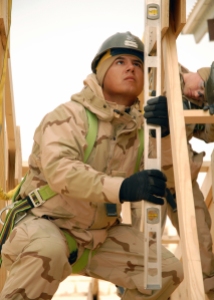 Imagine being told that you will not be paid for a house you constructed pursuant to a contract with homeowners. And imagine that the reason for not getting paid had to do with whether or not you signed a contract “on behalf of” your partnership or whether you simply signed your individual name. This is the exact case that Ron Medlin, partner in Ron Medlin Construction, is facing thanks to a recent North Carolina Supreme Court case, Ron Medlin Construction v. Raymond A. Harris, __ N.C. __, (December 20, 2010).
Imagine being told that you will not be paid for a house you constructed pursuant to a contract with homeowners. And imagine that the reason for not getting paid had to do with whether or not you signed a contract “on behalf of” your partnership or whether you simply signed your individual name. This is the exact case that Ron Medlin, partner in Ron Medlin Construction, is facing thanks to a recent North Carolina Supreme Court case, Ron Medlin Construction v. Raymond A. Harris, __ N.C. __, (December 20, 2010).
Ron Medlin entered into a contract with the Harris’ for the construction of a home not to exceed $604,800. Of note, Medlin did not have a licensed general contractor’s license, as is required. However, Ron Medlin Construction, a partnership, was appropriately licensed as a general contractor, and the partnership performed the work relating to the construction of the residence.
When litigation arose over cost overruns, the Harris’ claimed they did not need to honor the contract because it was with an unlicensed contractor. Under North Carolina law, any person who performs work in excess of $30,000 needs to be appropriately licensed or he cannot recover for his work in the Courts. (See Brady v. Fulghum, 309 N.C. 580, 586, 308 S.E.2d 327, 331 (1983)). The partnership argued that it did not have a contract with the Harris’, yet it performed work in constructing the residence and, therefore, was entitled to recover a just amount under a theory called quantum meruit. The Court held that the partnership ratified Ron Medlin’s individual acts, and as such the partnership was bound by the (unenforceable) contract and could not recover.
The Court held, as a matter of law, that:
a contract for the construction of a home or building executed by a partner in a licensed partnership engaged in the construction business is the contract of the partnership unless the remaining partners can show that the partner was not authorized to act on behalf of the partnership and, if not so authorized, the partnership did not ratify the contract.
Moral of the story? It is important that you follow the rules in signing and performing under construction contracts, as well as in maintaining your proper corporate formalities. It might even be worth having your attorney review your construction contract before you sign it. Unless, that is, you don’t mind that chance that you may end up performing some of your work for free.
Take a minute right now and sign up for email updates so you never miss one of the posts!
—————————–
Photo: “361/365 days -it feels good to stop” by badjonni via Flickr/Creative Commons license.



